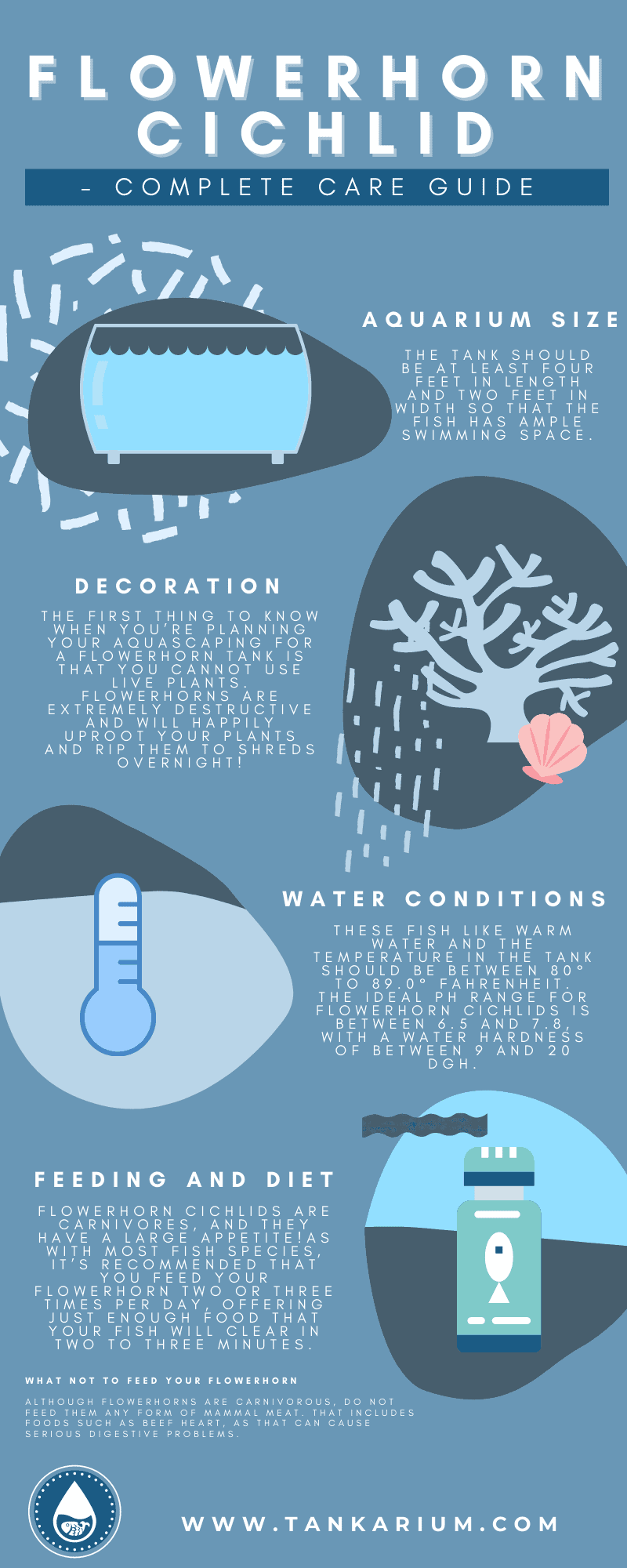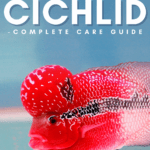The King Kamfa Flowerhorn cichlid, Amphilophus hybrid, is a weird-looking freshwater tropical fish that is an amazing feature in any aquarium that certainly makes a talking point for visitors to your home!
Some hobbyists consider Flowerhorns to be deformed fish, whereas others love these quirky creatures and their bizarre looks. But that’s down to personal preference.
But how long do Flowerhorns live? Do Flowerhorns like to be petted? And can you keep a Flowerhorn in a 2-foot tank?
Read this guide to find out if a Flowerhorn would make a suitable pet for you.
Overview Of The Flowerhorn
Scientific Name
Amphilophus hybrid
Common Name (species)
King Kamfa, luohan, Golden Monkey
Family
Cichlidae
Origin
Artificially created hybrid cichlid
Diet
Artificially created hybrid cichlid
Care Level
Beginner-friendly
Lifespan
8 to 10 years
Temperament
Semi-aggressive
Tank Level
Swims in all areas of the water column
Minimum Tank Size
70 gallons
Temperature Range
77 to 840 F
Water Hardness
8 to 20 dGH
pH Range
7.0 to 8.0
Filtration/Flow Rate
Moderate
Water type
Freshwater
Breeding
Challenging, egg-layers
OK, for Planted Tanks?
Large, active diggers that can disturb plants
Brief History of Flowerhorns
Flowerhorns are artificially created hybrid fish that don’t exist in the wild.
That said, there are a few wild populations of Flowerhorns in parts of Central America. These fish were probably released into local waterways by their owners once the Flowerheads grew too large for their tanks and are now regarded as an invasive species.
These fun freshwater fish were developed during the mid-1900s in Malaysia when breeders crossbred several varieties of South American cichlids, ultimately producing a fish with a huge “nuchal” hump. These early Flowerhorns were nicknamed “Karoi” because of their resemblance to the warships of the time.
The Flowerhorn’s genetic material most likely comes from any of the following cichlid species:
- Three-Spot cichlid
- Red Terror
- Midas cichlid
- Red Devil
- Redheaded cichlid
- Jingang Blood Parrot
Today, Flowerhorn breeders insist on maintaining pure bloodlines in their fish to ensure that the fish are healthy and retain their looks.
Hua Luo Han Cichlids
Today’s Flowerhorns are commonly known as the Hua Luo Han Cichlids. These fish were created in the late 1900s by crossbreeding the hybrid Jingang Blood Parrot with the Blood Parrot.
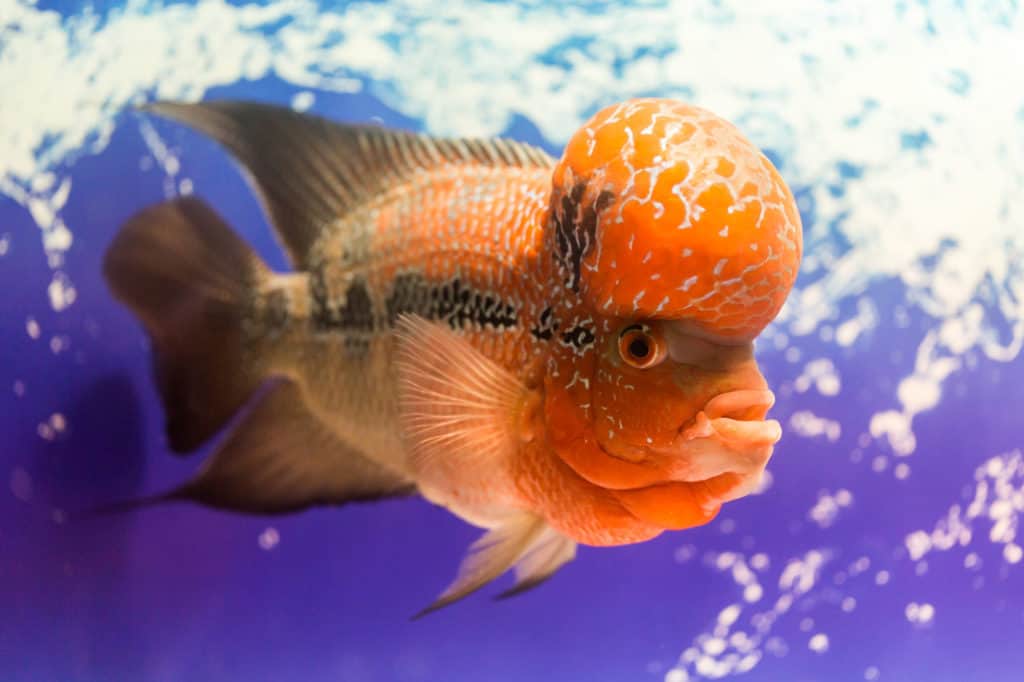
Originally, these fish were golden-colored, but by 1999 there were four distinct Flowerhorn strains:
- Regular Flowerhorns
- Zhen Zhu Golden Flowerhorns
- Pearl Scale Flowerhorns
- Flowerhorns that fade
Further hybridization took place, and in the early 2000s, “Kamfa” strains appeared, possessing massive nuchal humps, wraparound tails, brighter colors, shorter mouths, and sunken eyes.
Fortune Fish!
In Asia, fish keepers regard the Flowerhorn as a lucky fish that brings good Feng Shui and fortune to its owner, influencing relationships, wealth, and success in business.
Indeed, if you’re lucky enough to own a huge fish with striking colors, color variants, or a very large head protuberance, you could sell your pet for thousands of dollars.
So, perhaps the fish’s reputation as a bringer of fortune is true!
Flowerhorn Appearance
Flowerhorn cichlids are easy to recognize thanks to their odd looks, which make them one of the coolest aquarium fish you can buy!
Male and female fish both have oval-shaped, chunky bodies and a characteristic Flowerhorn head bump or nuchal hump.
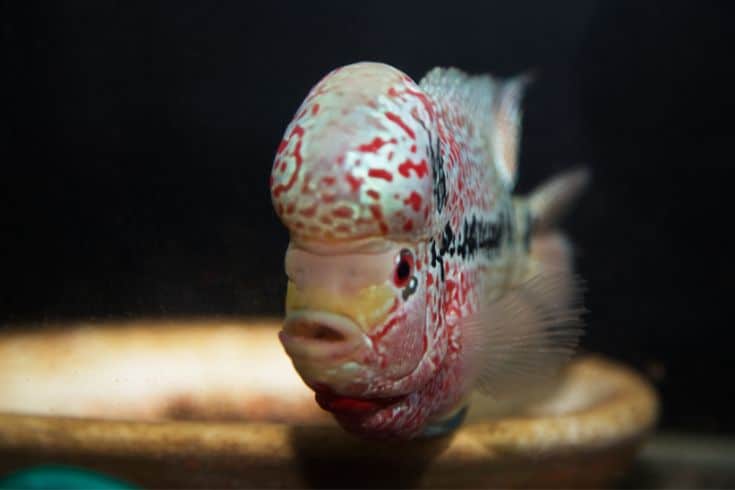
The fish’s scales are metallic greenish-blue, appearing a reddish-orange color toward the front of the fish, and most Flowerhorns possess horizontal black stripes. Other color varieties are sometimes seen, too.
Flowerheads have long, pointed anal and dorsal fins and round spade-shaped caudal fins. For defense against predators and other Flowerhorns, the fins have spiny rays toward the rear. Although Flowerhorns are not fast swimmers, they can position themselves accurately and tend to gravitate to open water.
Flowerhorn Fish “Standards”
Enthusiasts like to show their Flowerhorns in competitions, and there are seven “standards” that the fish are judged against, which are:
- Nuchal hump or characteristic Flowerhorn head bump
- Body shape
- Vibrant colors
- Metallic or pearlized scales
- Black horizontal markings
- Erect fins and tail
- Prominent eyes
Like other cichlid species, Flowerhorns have regular teeth and a set of prominent teeth set into their throats. The fish’s nostrils are used to “inhale” water, which they use to sample “smells” in the water, which are then expelled.
Color Changing
Flowerhorns are colorful freshwater fish that gradually change hue as they age. That makes keeping one of these creatures fascinating since you can never be sure exactly what you’ll end up with!
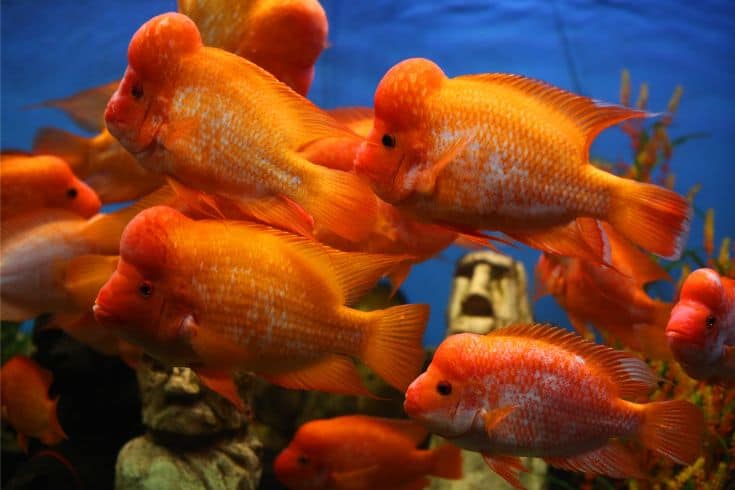
What Size Are Flowerhorns?
Male Flowerhorns can reach 12 inches long, making them larger fish than average. Females are somewhat smaller.
You can also find short-bodied varieties of Flowerhorns known as Bonsai or Balloon Flowerhorns that grow to just 6 inches.
Life Expectancy
Flowerhorn cichlids have an average lifespan of 10 to 12 years.
Flowerhorn Activity Level and Temperament
Flowerhorns are extremely active, intelligent fish, spending plenty of time cruising around their aquarium and digging in the substrate.
Unfortunately, these fish are highly territorial and aggressive, making them unsuitable for life in a regular peaceful community tank housing smaller fish. However, these are interactive fish that will form a bond with their owners and can be hand-fed and even petted!
Compatibility and Tankmates
Thanks to their aggressive tendency, finding suitable tank mates for Flowerhorns is not easy.
Flowerhorn Cichlid Tank Mates?
Unless you have a very large aquarium of at least 200 gallons, it’s not a good idea to keep the aggressive Flowerhorn with other fish.
There are even reports of these fish attacking their keepers during tank cleaning and routine maintenance tasks, inflicting minor injuries!
That said, you could try keeping other large semi-aggressive fish with a Flowerhorn, such as Oscars, Arowanas, and the like. If you do go down that route, be sure to use lots of hardscapes to create natural boundaries and territories to keep the fish segregated.
Invertebrates
Do not include invertebrates, such as shrimp or snails, with a Flowerhorn. These fish are carnivores that will regard inverts as a food source.
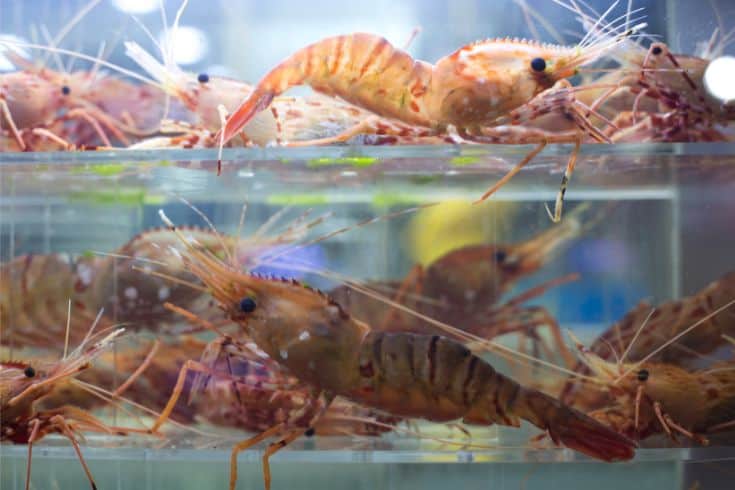
How Many Flowerhorns Should Be Kept Together?
Although most people keep one single Flowerhorn, it is possible to keep them together, provided you introduce the fish to your tank at the same time and when they are juveniles. Seemingly, if the fish grow up together, they are much less likely to fight.
Often, mated pairs of Flowerhorns will live together happily. That said, males have been known to attack and kill their mates if the female encroaches too much on their territory.
Appropriate Diet For Your Flowerhorn
Flowerhorns are carnivores with a BIG appetite!
These fish will eat pretty much whatever you offer them, including fresh, live, or frozen meaty foods. You must keep your pet’s diet varied, too, as that will enhance the fish’s colors. Favorite foods for Flowerhorns include nightcrawlers, crickets, cichlid pellets, and bloodworms.
Supplementing the diet with vitamins and minerals is a good idea, especially if you include carotene to boost the fish’s bright colors.
What Not To Feed Your Flowerhorn
Do not feed your Flowerhorn any type of mammal meat, such as beef heart. That can cause serious digestive upsets for your Flowerhorn.
Frequency and Amount of Feeding
Feed your fish two or three times every day, offering only what your fish will clear up in a couple of minutes.
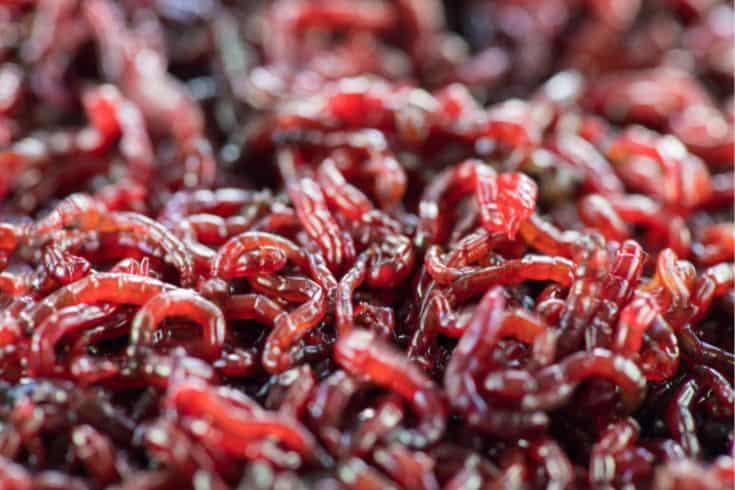
Tank Requirements
Flowerhorns are pretty straightforward to care for and are beginner-friendly fishes that can make great pets.
Aquarium Size
Flowerhorns need an average-sized tank of at least 70 gallons for one fish to allow the creature plenty of growing space and room to swim. Ideally, your tank should be at least 4 feet long and 2 feet wide.
However, if you want to keep a mated pair of Flowerhorns, our minimum tank size recommendation is a 150-gallon tank. If you create a community tank, you need a larger tank of 200 gallons as a bare minimum.
Tank Setup
Substrate
The best substrate for a Flowerhorn tank is gravel. Be careful to choose gravel without sharp fragments; Flowerhorns love to dig, and your fish could easily be injured while he’s rooting around if the gravel pieces are abrasive.
Decoration
Since Flowerhorns are territorial, so an ideal tank setup should include driftwood, twisted roots, and rockwork to create natural boundaries within the setup, especially if you intend to keep a pair of Flowerhorns or some other fish.

These fish are active, large, and pretty powerful, so you must ensure your decorations are well-anchored in the substrate to prevent them from being knocked over.
Plants
Flowerhorns won’t eat your plants, but they will probably uproot them. Even if you use terracotta pots to house your plants, there’s a good chance the fish will knock them over.
For that reason, you should choose column-feeding species that will grow attached to rocks or wood. Habitat Requirements
Lighting
Flowerhorns are not fussy when it comes to aquarium lighting, doing fine with regular LED tank lights.
Filtration
Flowerhorns are large, dirty fish, and they will make plenty of mess in your aquarium.
So, to ensure good aquarium water quality, you need a highly-efficient filtration system to cope with the bioload these fish produce. Ideally, you want a filter unit that puts out a moderate flow throughout the tank and keeps the water highly oxygenated.
Water Parameters
Temperature
Flowerhorns are tropical fish that like a very warm tank temperature of 77 to 84 degrees F, although they will tolerate temperatures up to 89° F.
Water Hardness and pH Range

The ideal pH for Flowerhorn cichlids is between 6.5 and 7.8, with the water hardness in the range of 9 to 20 dGH.
Tank Maintenance
As previously mentioned, Flowerhorn cichlids are dirty fish that produce lots of waste. Each week, you need to change 25% of the tank water, taking care to vacuum the substrate to remove fish waste, uneaten food, and other organic debris from around the bottom of the tank.
Use an algae scraper to remove algae from the viewing panes and trim away dead plant leaves and broken stems.
Finally, remember to rinse filter media in old tank water to remove clogging so that your filter unit works efficiently. Periodically, you’ll need to replace spent filter media.
Setting Up the Aquarium
Assemble everything you need to set up your Flowerhorn tank, including the following items:
- Gravel substrate
- LED lighting unit
- Canister filtration system
- Water dechlorinator
- Heater
- Digital thermometer
- Tank decorations
- A selection of hardy plants
How to Set up Your Flowerhorn Tank

- Wash the substrate under clean water.
- Put a few inches of the substrate into your aquarium.
- Put your fish filter and heater into your tank, but don’t switch them on.
- Add dechlorinated tap water to just below the aquarium fill line. I find placing an upturned dish on top of the substrate prevents the water from displacing it.
- Wash the tank décor to get rid of dust, and then add your decorations to the aquarium.
- Tidy up the plants, removing dead leaves and damaged stems, and add them to your aquarium. Leave space between the plants for them to grow.
- Turn on your heater and filter. Remember that your live plants need eight to ten hours of light daily for photosynthesis.
- Test the water daily until ammonia and nitrites are at zero and nitrate is below 20 ppm, and then add your Flowerhorn.
Flowerhorn Health and Disease
Flowerhorns are pretty robust and don’t suffer from many diseases if you give them optimum tank conditions and a high-quality, varied diet.
However, there are a few common freshwater fish diseases that can affect Flowerhorn cichlids
Signs of Good Health
Healthy Flowerhorns are brightly colored, active fish that spend lots of time digging in the substrate and swimming around the mid to upper levels of the water column.
Red Flags
There are some red flags that could indicate potential problems in your Flowerhorns, including the following:
- Poor appetite
- Inactivity
- Skin damage, such as sores, ulcers, or red patches
- Rubbing against solid objects in the aquarium
Common Health Issues and Treatment
Health Issue
Ich (White Spot Disease)
Symptoms or Causes
Ich is a very common disease that’s caused by an aquatic protozoan parasite.
Fish infected with Ich develop a sprinkling of tiny white spots on their fins, gill covers, and bodies. They also flash against the gravel and other solid objects in the aquarium.
Suggested Action
Raise the water temperature to 82o F for three days. Use an OTC White Spot Disease medication to treat the tank.
Health Issue
Flukes
Symptoms or Causes
Flukes is the term used to describe various types of external fish parasites. These macroparasites can often be seen with the naked eye attached to the fish’s skin or gills.
Suggested Action
Treat the fish tank with an OTC antiparasitic medication.
Health Issue
Fungal infections
Symptoms or Causes
White fluffy growths on the fish’s body, mouth, and head.
Suggested Action
Quarantine infected fish, and treat with an antifungal medication.
Health Issue
Bacterial infections
Symptoms or Causes
Sores and ulcers on the body and head, ragged, bloody fins.
Suggested Action
Treat the tank with OTC antibacterial treatment.
Keep your fish healthy by feeding them high-quality Flowerhorn fish food and keeping your tank clean and well-maintained.
Breeding
Unlike many hybrid fish species that often produce infertile males, some Flowerhorn specimens can breed.
However, thanks to the mature males’ aggressive nature, breeding attempts in the home aquarium is no easy task, even if you do find a breeding pair that are physically capable of reproducing.
If you decide to try a breeding program with your Flowerhorns, we recommend using a dedicated spawning tank.
Spawning Tank
Your spawning tank needs plenty of rocks and other decorations that the female fish can use for shelter if her mate becomes aggressive.
One proven way of keeping your female Flowerhorn safe during the breeding process is to use a tank divider positioned just above the tank bottom on the female’s side. Put a flat rock right next to the divider and make that the only spawning location in the tank. Direct the pump outflow from the male’s side of the tank to the female’s.
When the female deposits her eggs on the rock, the male will fertilize them without requiring any interaction between the two fish.
For perfect spawning conditions, the water temperature in the breeding tank needs to be around 82° Fahrenheit, and the water pH should be 7.0.
Conditioning
The Flowerheads can be brought into spawning condition by feeding them a high-quality diet multiple times every day for a few weeks. Of course, that creates lots of fish waste, so you must keep on top of your tank maintenance by performing frequent water changes and using your aquarium vacuum to keep the substrate clean.
Flowerhorn Fry Tank
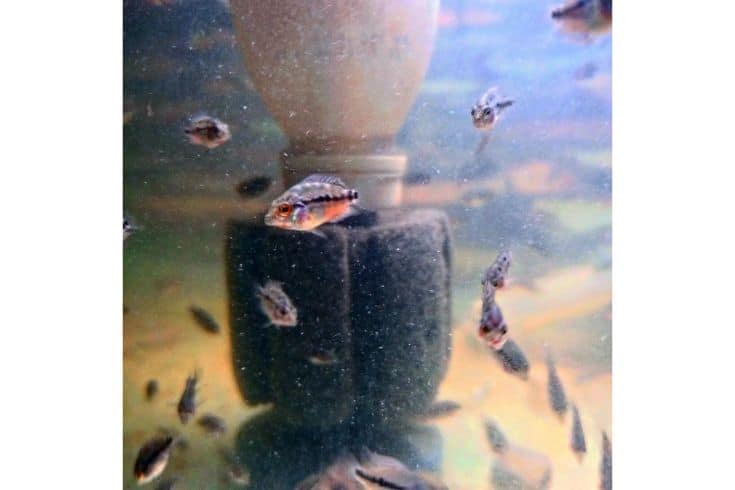
Once the eggs are fertilized, both parent fish guard the clutch until they hatch, and it’s at this stage the male is most likely to become aggressive toward his mate. If you’ve left both Flowerhorns together without a tank divider, you’ll need to remove the female if the couple begins squabbling.
As soon as the fry hatch, we advise removing the male Flowerhorn to prevent him from eating the babies.
Fish food companies produce special fry food, and Flowerhorn fry can also be fed baby brine shrimp until they’re a couple of weeks old and big enough to cope with cichlid pellets or crushed flakes.
Availability
Flowerhorns are typically available in most fish stores, and you can also buy them online.
What you’ll pay for your Flowerhorn depends on a few factors, including the specimen’s age, markings, size, and color. Mature fish tend to be larger, have the most unusual markings, and largest nuchal humps, so these are the most expensive.
An adult, well-marked Flowerhorn will set you back $100 or more, whereas a smaller juvenile fish will cost around $20.
If you’re interested in breeding Flowerhorns, you can buy your fish in pairs, which often works out cheaper.
Product Recommendations
- Water dechlorinator
- Algae magnet
- Aquarium thermometer
- Aquarium vacuum cleaner
- Books on keeping Flowerhorns
- Filtration system
- Fish tank (minimum size 70 gallons)
- Heater
- A selection of cichlid foods and frozen meaty foods
- LED lighting unit
- Sturdy plants, such as Anubias
- Tank decorations
- Gravel substrate
Final Thoughts
I hope you enjoyed our guide to keeping Flowerhorn cichlids. If you did, please share the article before you go!
Flowerhorns are distinctive, unusual fish that are surprisingly easy to care for and can make fun pets. However, these weird-looking, hybrid fish are highly territorial and are not recommended for life in a community tank.
That said, you can sometimes keep two Flowerhorns together safely, provided you introduce them both as juveniles and at the same time. Other large, semi-aggressive fish can also live with Flowerhorns relatively safely.
Do you have a lucky Flowerhorn? Tell us about your exotic fish pet in the comments box below!
